Spicy Pork Bulgogi (Jeyuk Bokkeum)
Jeyuk Bokkeum (spicy pork bulgogi) is a quick Korean stir-fry that tastes like it came straight off the BBQ grill. Tender pork slices are coated in a gochujang sauce that turns smoky, sweet, and caramelized in just minutes—perfect for an easy weeknight meal with rice or lettuce wraps.
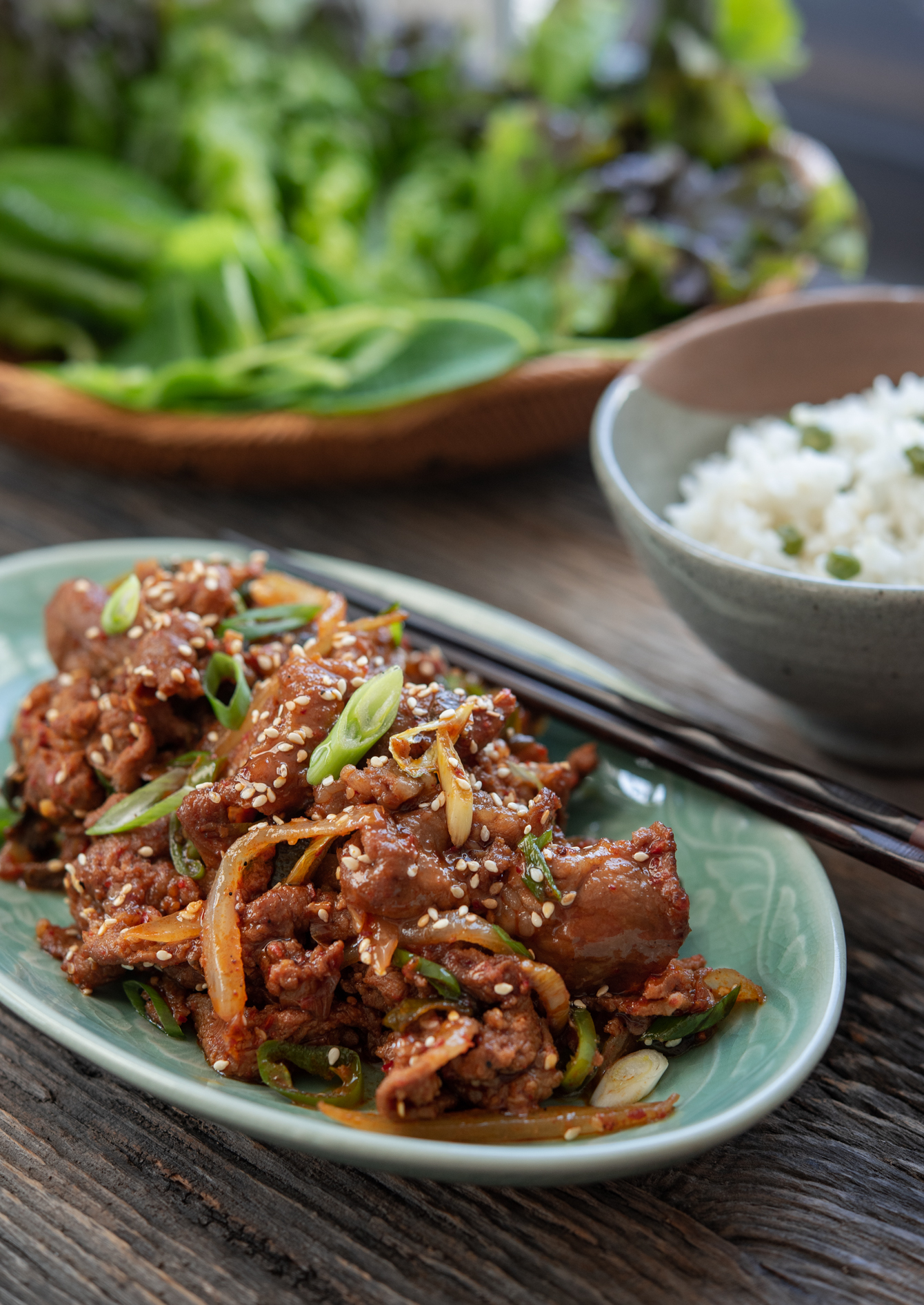
When it comes to Korean food, Jeyuk Bokkeum (spicy pork bulgogi, 제육볶음, or dwaeji bulgogi) is a must-try classic. Thin slices of pork shoulder or pork neck are coated in a sweet-and-spicy gochujang sauce, then quickly stir-fried to smoky perfection. It’s a Korean BBQ favorite that tastes just like what you’d find in Seoul, and it comes together in minutes at home.
The key to great Jeyuk Bokkeum isn’t just the sauce—it’s how you cook it. Ever had one that’s watery or lacking that deep, smoky flavor? After countless tests, I found a foolproof method to create the same charred sweetness you get from Korean BBQ.

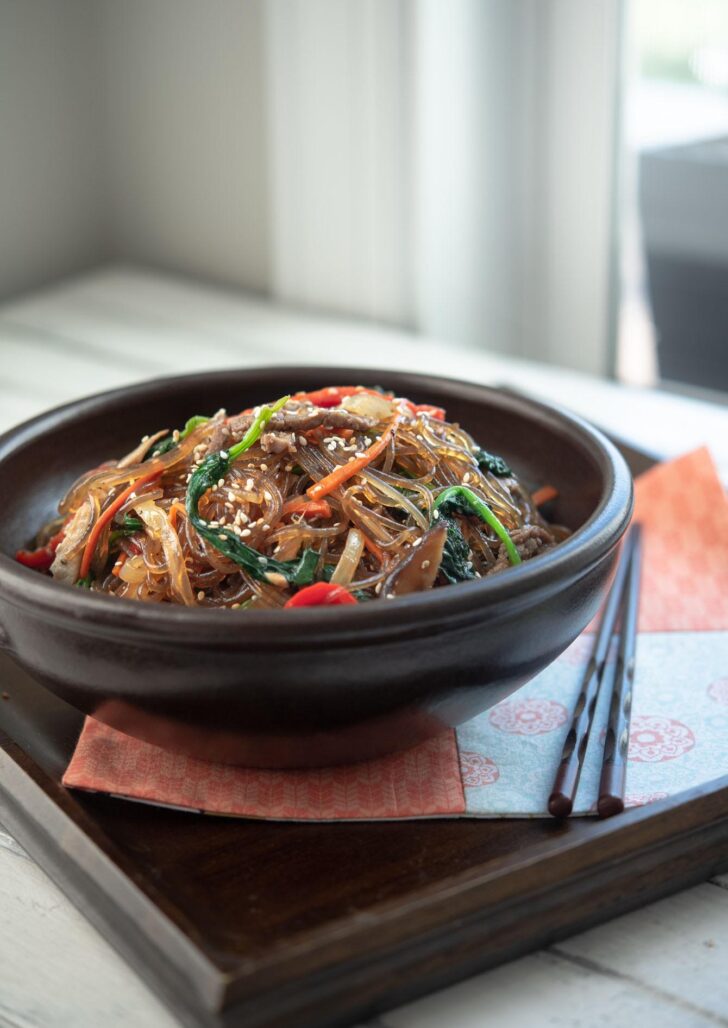
Get new recipes via email:
This is my go-to version, tested and loved by readers for years, and It’s one of those dishes that turns simple pork into pure comfort.
Why This Jeyuk Bokkeum is Better
Caramelized Sugar for Deep Smokiness
Many recipes rely on hours of marinating to build flavor, but that doesn’t always create the smoky depth I crave. After trying numerous times, I found a better way: caramelizing sugar with leeks (or scallions) in oil before adding the pork. This trick mimics the smoky char of Korean BBQ, giving the pork a rich, caramelized depth—without drying it out.
If you love gochujang-based stir-fries, you might also enjoy my Dakgalbi (Spicy Chicken Stir-Fry). It shares the same balance of heat, sweetness, and smoky depth that Korean BBQ is known for.
No Long Marinade Required
You can skip the long wait—just mix and cook right away! Of course, you can still marinate the pork for up to an hour or overnight if you prefer. But if you’re in a hurry, this method delivers that signature spicy-sweet flavor in under 20 minutes. Easy, quick, and so delicious!
Key Ingredients for the Best Spicy Pork Bulgogi
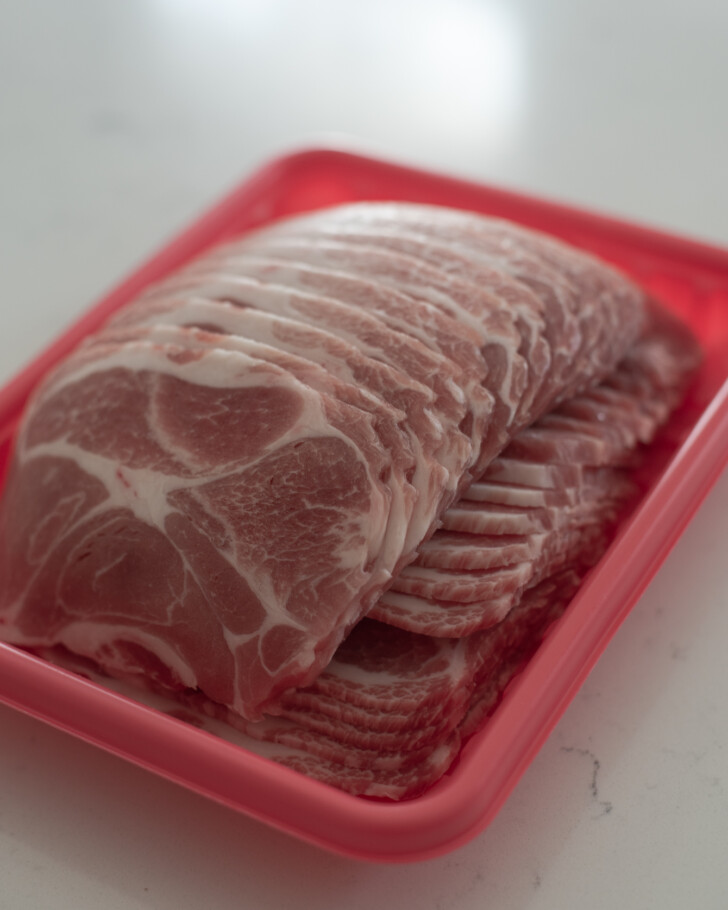

For the best flavor and texture, choose pork with some fat (marbling) to keep it moist. Pork shoulder (moksal) or pork butt is ideal, as they have the right balance of lean meat and fat.
Tip: You can also use chicken thighs or tofu for variation, similar to my Chicken Bulgogi recipe.
You’ll also need gochujang (Korean red chili paste), gochugaru (red pepper flakes), soy sauce, rice wine, sugar, garlic, ginger, sesame oil, and sesame seeds for the sauce.
Step-by-Step: Cooking the Pork to Perfection


Make the Marinade. Combine the seasoning ingredients to create a rich gochujang-based sauce. The key is balancing heat, salt, and sweetness. Mix until smooth, then add the pork slices and toss to coat evenly. The sauce will cling better if your pork is thinly sliced and slightly chilled.
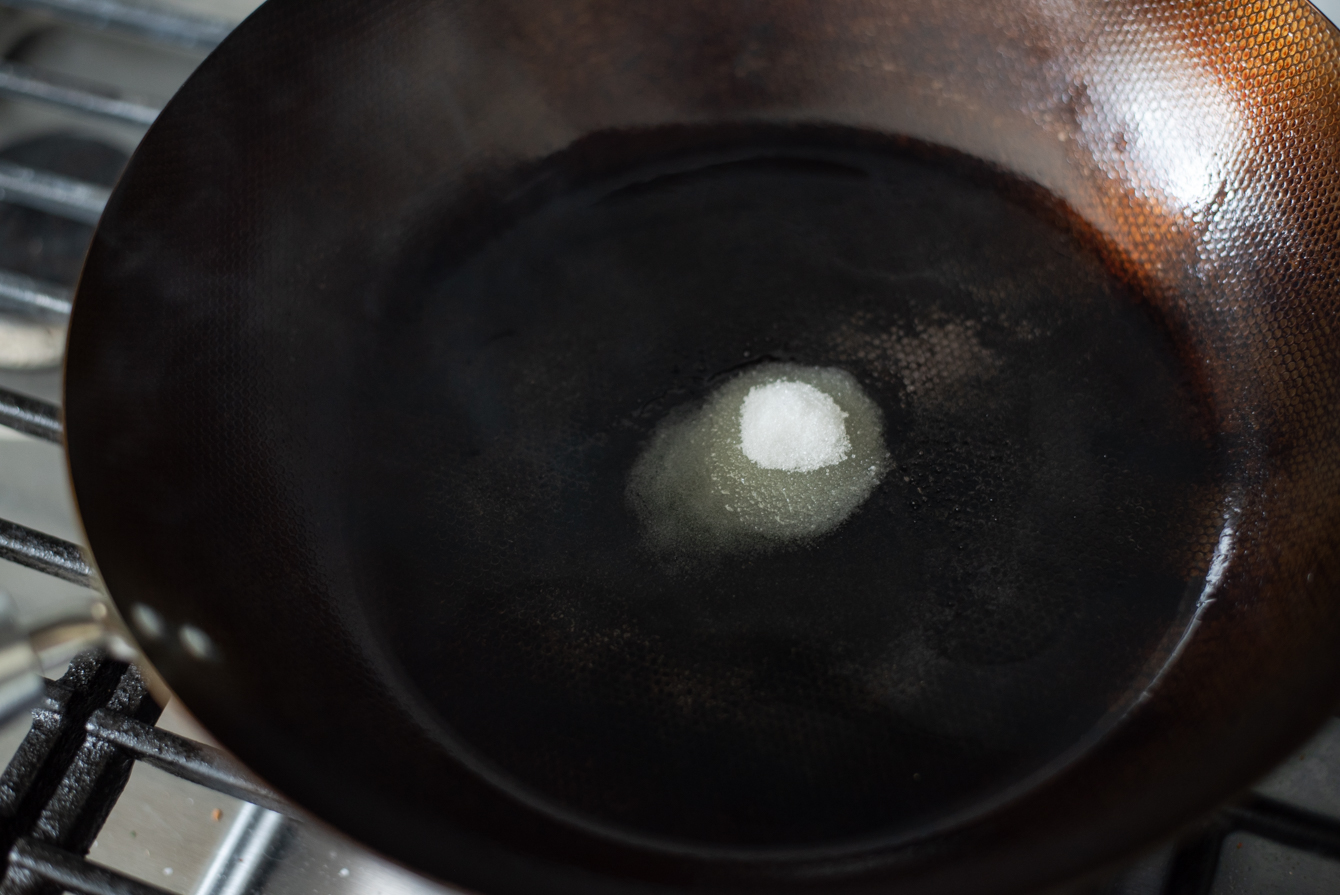
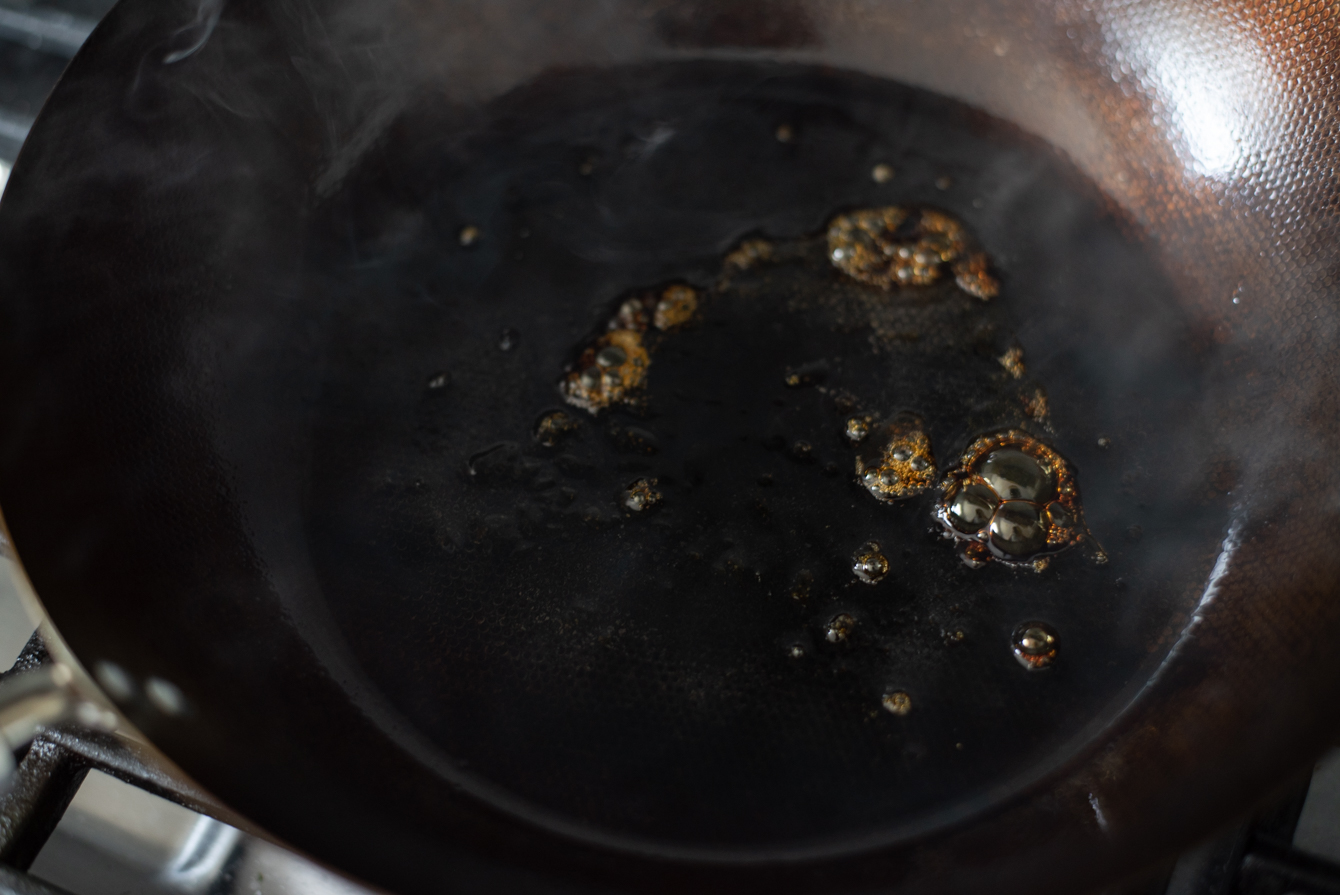
Caramelize the Sugar. Heat a little oil, then sprinkle in the sugar. Let it melt slowly over medium heat until it turns a deep amber color. This step builds a smoky sweetness that mimics the char you’d get from grilling. Be patient and don’t stir too soon; once the sugar darkens, swirl the pan gently to keep it from burning.

Stir-Fry the Leeks. Add the chopped Asian leek (or green onion) and sauté briefly to flavor the oil to build aroma.
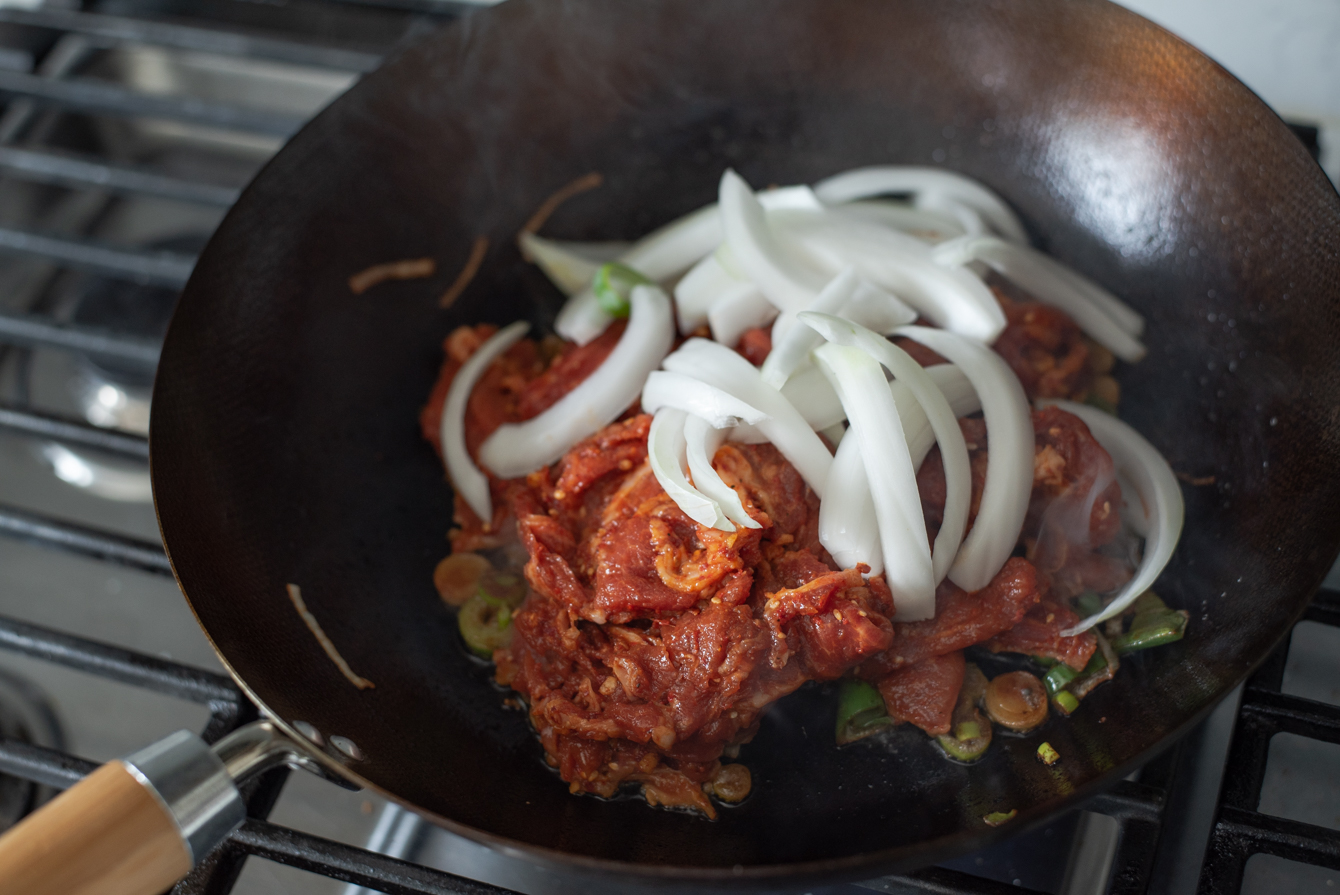
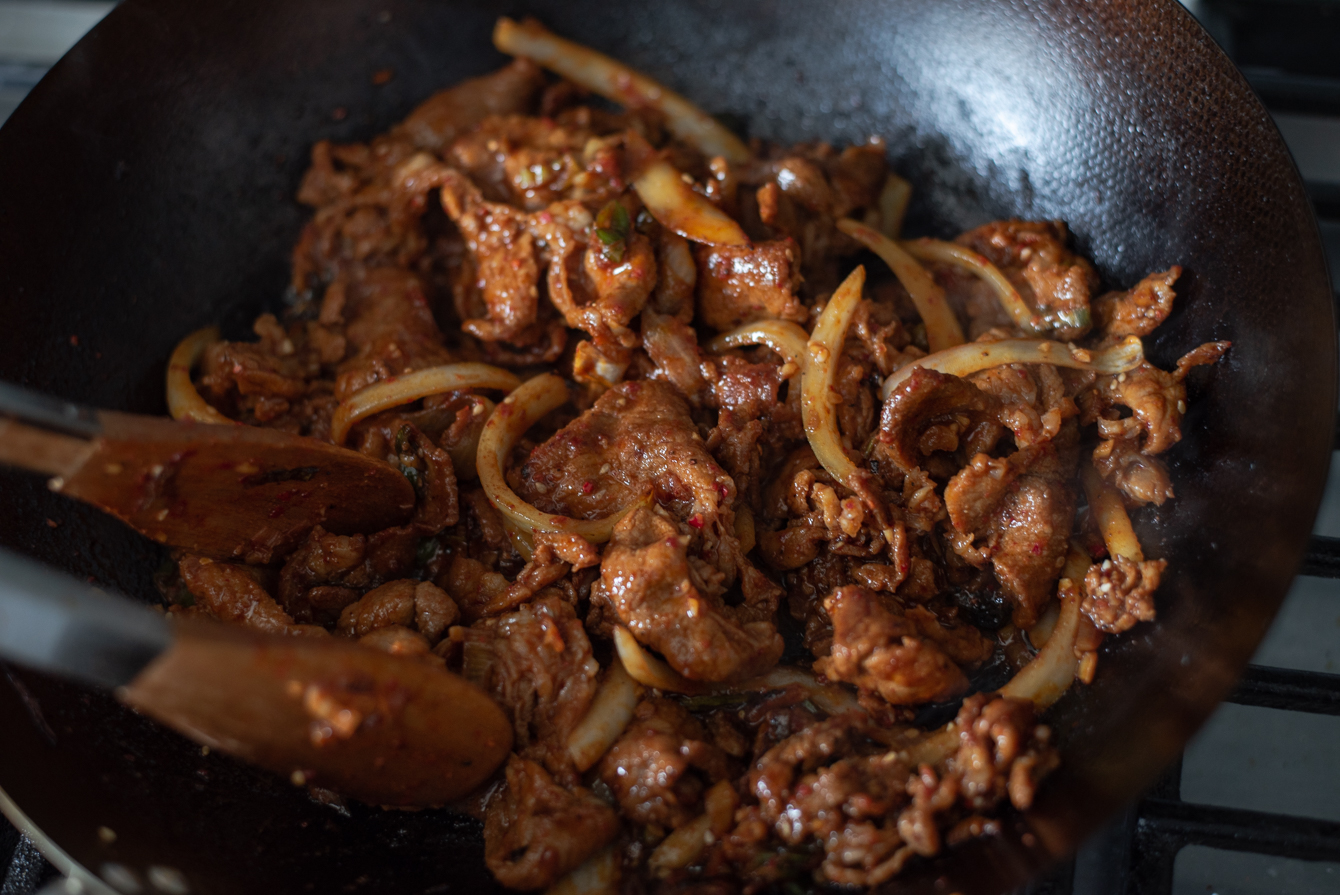
Add the Pork, Onion and Stir-Fry. It should sizzle on contact. That quick sear locks in moisture and helps the sauce caramelize for deeper flavor. Stir-fry until the pork is just cooked through and tender with a glossy coating.
Serving Ideas & Korean Meal Pairings
For me, jeyuk bokkeum is best with a simple bowl of steamed rice and a few Korean side dishes. But it’s even better wrapped in fresh greens — crisp lettuce or aromatic perilla leaves (kkaennip) add that satisfying crunch and earthy flavor.
For a fuller meal, many Korean families enjoy it with a bowl of doenjang jjigae (soybean paste stew) on the side. However you serve it, the combination of spicy, smoky pork and fresh, clean flavors never disappoints.
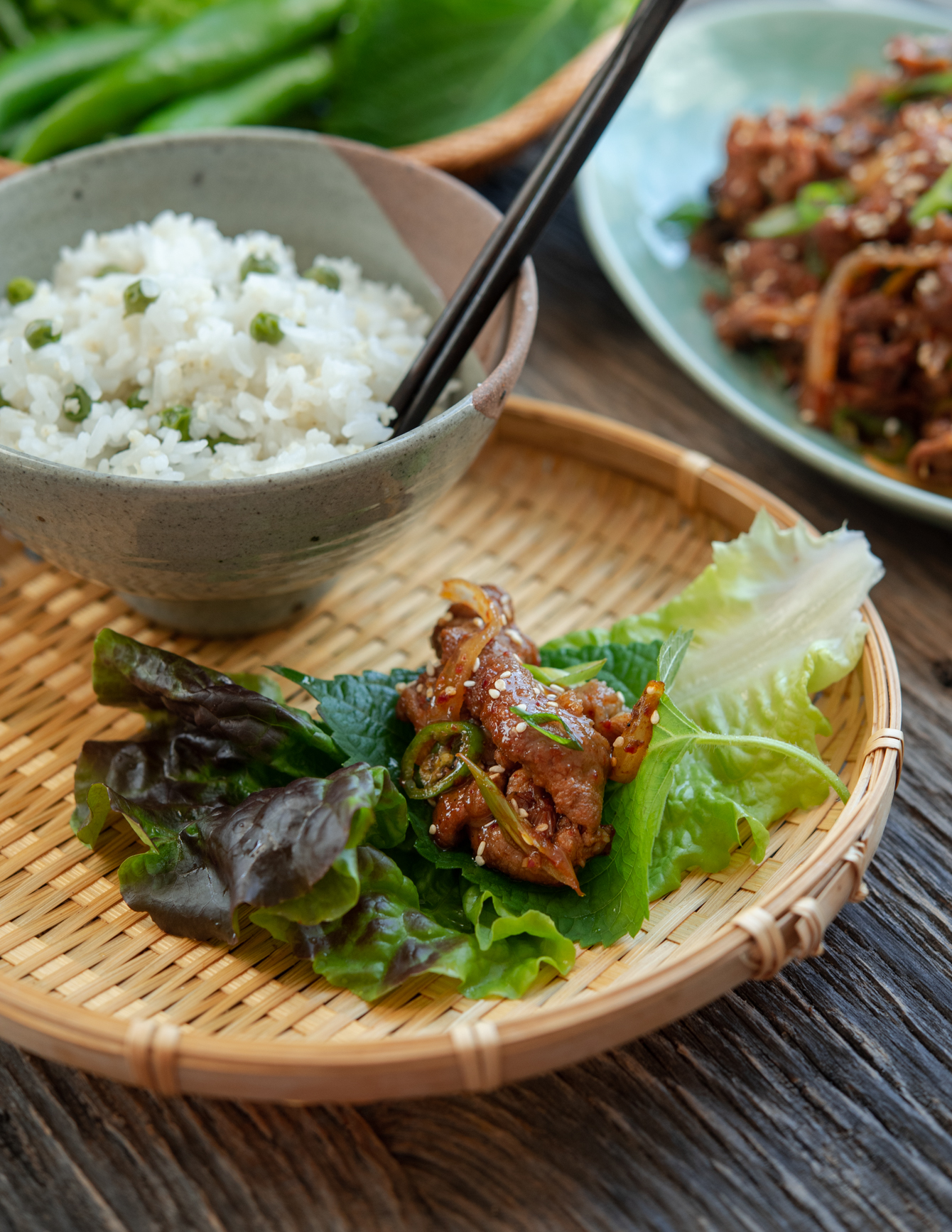
Love this recipe? Rate it and share your experience in the comments below! On Instagram? Tag me to showcase your creation. For more delicious recipes, subscribe to our newsletter!
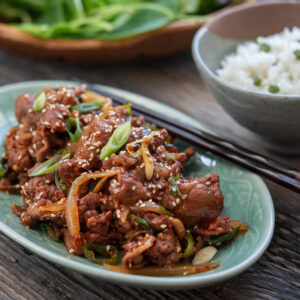
Spicy Pork Bulgogi (Jeyuk Bokkeum)
Ingredients
- 2 lb (900 g) pork shoulder , or pork butt, very thinly sliced
- 2 tbsp (30 ml) canola oil
- 2 tsp (8 g) sugar
- 1 Asian leek , or 4 green onion, chopped
- 1/2 large onion, sliced
For seasoning paste:
- 6 tbsp (90 g) Korean chili paste (gochujang)
- 1-2 tbsp (6–12 g) Korean chili flakes (gochugaru)
- 2 tbsp (30 ml) soy sauce
- 2 tbsp (30 ml) sweet rice wine (mirim)
- 2 tbsp (24 g sugar
- 3 cloves garlic, finely minced
- 1 1/2 tsp (7 g) ginger paste
- 1 tbsp (15 ml) sesame oil
- 1 tbsp (9 g) toasted sesame seeds
- 1/2 tsp (2 g) black pepper
Instructions
- To make the seasoning paste for pork, combine chili paste, chili flakes, soy sauce, rice wine, sugar, garlic, ginger puree, sesame oil, sesame seeds, and black pepper in a small mixing bowl; mix well.
- In a large mixing bowl, separate each slice of pork and put them in a bowl. Add the seasoning paste and mix well (Wearing a disposable food glove is helpful). You can make this step ahead of time and let it marinate in the refrigerator up to 24 hrs. Or you can go straight to stir-fry without marinating at all.
- Heat 2 tablespoon of oil in a deep skillet or wok over high heat. Add 2 teaspoon of sugar and swirl the pan around. Let the sugar turn brown and caramelized.
- Quickly add the chopped Asian leek (or green onion) and stir-fry for 30 seconds to infuse the oil. Add pork and onion. Stir-fry pork and onion until they are fully cooked and tender, about 3-4 minutes. Serve immediately with rice and lettuce (if desired).
Notes
Recipe Success Tips
- Pork Slicing: Slice pork about ⅛ inch thick for even cooking and better marinade absorption. Pre-sliced pork shoulder is often available at Korean grocery stores. If cutting it yourself, freeze the meat for an hour first—it makes slicing easier.
- High Heat & Best Cookware: Stir-fry over high heat to quickly evaporate moisture and create a deep sear, just like Korean BBQ. Use a cast-iron skillet or carbon-steel wok for the best heat retention and caramelization—nonstick pans can’t handle the temperature needed for that smoky, charred flavor.
- Avoid Overcrowding: Cook in batches to prevent steaming. Leave space between pork slices and let them sear undisturbed for a smoky, juicy bite.
Storage and Reheating
- Let leftovers cool completely, then store them in an airtight container in the fridge for up to 3 days. For longer storage, freeze for up to 2 months.
- For the best flavor, reheat in a pan over medium-high heat until warmed through. If it looks dry, add a little oil. Avoid microwaving, as it can make the pork tough and gamy.


How do you make this without the marinade sticking to the pan and burning instantly? I could make the first batch of meat fine, but I had to spend like ten minutes scrubbing it before doing the second batch, there was this 0.5 cm layer of black burnt stuff. I’d prefer to not to have to deal with that clean-up next time. Was using a non-stick pan the problem (I don’t have other ones)? Or did I get the heat setting wrong?
Hi! That can definitely happen with spicy marinades since the sugar and gochujang burn quickly. Try cooking the pork over medium to medium-high heat instead of high and don’t overcrowd the pan (too much sauce at once can caramelize too fast). You can also oil the pan between batches or add a splash of water to loosen the sauce if it starts sticking. A non-stick pan is fine, just keep the heat moderate. Hope that helps for next time!
Hi, I bought Sun Hee Gochujang Korean hot chilli paste. Is this correct paste? I tried a little to taste it, boy that is HOT. There is no way that I am putting 6tbs of that in. Might try two teaspoons at most.
Commercial gochujang varies in flavor and heat depending on the brand—some are much spicier than others! I’m not familiar with that specific brand, but it sounds like you got a particularly hot one. If you prefer less heat, try reducing the gochujang to half and adding more soy sauce instead. You can also cut back or skip the gochugaru, as it adds extra spice. Just a heads-up—this recipe is for 2 lb (900g) of pork, serving about 6-8 people, and 6 tablespoons of gochujang is a pretty standard amount for that quantity. Hope that helps!.
Absolutely delicious! This will definitely be a part of our meals from now on. It was spicy but not burn your mouth hot. The flavor was so good! The only addition was some cubed zucchini that was added because I needed to use it up.
Can I use ground pork for this recipe? Thanks!
Hi Lzzy
Ground pork will work with the recipe. Hope you like it. Thanks.
This was amazing! My first time cooking Korean food and it turned out so good I could eat it everyday. Regards from Sweden!
Hi, can’t wait to try this recipe this week. I made the chicken bulgogi last week and it was amazing!! I have a bit of a silly question though: Do you stirfry the slices of pork as they are or do you cut them into strips before?
If you bought the Korean style thin pork slices, you can use it the way it is or cut in half to make it smaller before you add the seasoning. Hope you like this pork bulgogi. It is delicious!
Made this recipe tonight. It is delicious, will definitely be making this often. Thank you for the recipe 😊
Hi Jean
So happy to hear that you liked it. Thanks for the comment. I appreciate it.
This pork looks so flavourful! Can’t wait to make it soon!
I made this. I was born in Seoul. However I HATE wasting leftovers! So if you will, laugh!
I used the dreaded honey baked ham as the meat. I omitted the sugar! It wasn’t authentic, but it was okay with a kick lol!
Nevermind. I had a second helping and although palatable the allspice and cinnamon powers through……ick! lol
Making this for a mother that does not like spicy food and a five year old brother, wish me luck on controlling the heat! I’ll likely leave out the pepper flakes.
You can leave the chili flakes out. Hope they like it.
Delicious, the 24 marinade is mandatory. Very tasty and not really all that spicy.
This is absolutely EASY and so TASTY. I struggle with some Korean dishes, as I usually mess something up and SOME TASTE is missing that I can’t point my finger at.
This was so easy, and turned out WONDERFUL. Both boyfriend and I loved it.
I used pork tenderloin thinly slice (as I had it on hand) – and while it took a bit longer to cook it was still perfect.
Thank you so much for this recipe! It’s a keeper!
That’s wonderful to hear! Glad that you liked this recipe. It is indeed simple to make and so delicious! Thanks for the comment!
Thanks so much for the recipe, I am very excited to try it! Just one question, when you say “Korean chili flakes,” is that the same as crushed red pepper flakes? If not, can you provide me with a photo of the jar/container your chili flakes come in? I couldn’t find “Korean chili flakes” in the store tonight. Thanks again!
I think I’ve answered my own question. I guess I should have Googled first *roll-eyes.*
Hi there! I just discovered this recipe through pinterest last week and I’ve already made it twice! My boyfriend and I love it! It was so quick and easy and tasty.
I followed your recipe this Sunday and served this to my friends at church. It was a big hit! Though, I had to substitute corn syrup with honey so it could have been sweeter than yours.
One thing I would like to mention is that H-Mart actually carries paper-thin cut pork for shabu shabu, but I don’t think that’s ideal for this dish. I found slightly thicker cuts of pork shoulder next to it, so luckily it turned out perfect!
Thanks for sharing these awesome authentic recipes!
Will it change the taste/texture to let it marinate overnight before cooking? Or do you recommend adding the sauce right before cooking?
Of course you can marinate overnight. It will intensify the flavor. Let it stand at least 15 minutes before you cook.
We go to a predominantly Korean church here in Arkansas and we cook every Sunday. As much as I love my Eldresses I know some of them don’t give the “secrets” to their dishes lol I have down the bulgogi and cucumber kimchi but until now couldn’t get a good flavor on my pork! Oh my this was perfect. I love this website!
Looks delicious!
맛있네 !!! like most of Korean dishes … greta pics and directions …
I made this and it was amazing. Thank you for the recipe Holly.
That’s great Atuk! Thanks.
Hi Holly, just wanted to let you know, that I’m a new, but avid reader of your entertaining blog. After some difficulties obtaining the ingredients (I hail from Germany) I cooked your Spicy Pork today. It was just wonderful! My son (13 yrs. and extremely choosey) loved it too! There are no left-overs, so the rest of the family will have to wait to taste it. 😀
Thank you!
I’m determined to make my spicy pork better. I’ve tried three different recipes, and your proportions seem best to me. I might omit the red pepper flakes as I find the gochujang quite spicy as is. I haven’t come across a recipe with corn syrup. I see it’s optional, but what exactly does it add to the dish that the regular sugar doesn’t? I’m curious. Thank you for a great site!
Hi Jerry, you can omit the corn syrup. Corn syrup gives a nice sheen to the dish. I highly suggest to add Korean chili flakes, though. It adds a nice spicy chili kick that gochujang alone doesn’t give. You can use only half the amount if the spiciness is a concern. Let me know if you need further assistance.
Beautiful, holly. I can just imagine having a mouthful of rice and this pork together. Yummm….
I finally cooked this last week and it was so so good! So much so that hubby was raving about it for days afterwards. So, I’m giving you love back for this.
And the pork neck meat is the right cut for this, just the right amount of fat. I couldn’t find the thinly sliced pork in my local butcher, instead I got a slab of pork neck meat and sliced them myself, I might have to do a post about this, hopefully sooner than later.
That is great to hear. Would love to see the post how you make the dish.
I just made this again today with a small handful of oyster mushrooms. And it’s as tasty and addictive as I remember it!!
Awesome! Mshrooms are great addition to this dish. Yeah, this spicy pork is quite addictive once you try it. Thanks!
Korean Pork is a great dish and easy to make. One of my favorites!!!
Big bowl of rice please! This is wonderful… I love pork dish and although I cannot eat very spicy food, I will control the level of spiciness. My mouth water by looking at your beautiful pictures. Whenever I come to your site, it makes me think I need to have good light and good photography skills to convince everyone it’s good food. You’re always doing amazing job!
You are so sweet Nami. Thanks for the compliment. I think having the natural light is the best tool for good photography and I still need to understand how to use light more properly. What type of lighting do you use in your pictures?
I also feel like I’m the only Korean/Asian who does not do well with Math. All through school and even college, I received A’s in every subject except Math and Science! :-(. Food looks delicious! I will have to try the recipe.
Some of my favorite ingredients are listed here! I love how easy and flavorful this is.
Oooooooh wow wow wow! This looks beautiful, and I will definitely be making this. How lovely. We don’t have an Asian market in our town, and I don’t want to wait until my next trip (our nearest Asian supermarket is approx 25 miles away) so I will be attempting to thinly slice the meat myself. I’ll semi-freeze it first so I can get it lovely and thin like that.
Delicious, Holly, as always – thank you for posting.
Semi freezing is great way to cut meat thinly. Let me know how you like the dish, Vicky. Thanks!
Mmmm… Jeyuk bokkum is one my favorites! I sucked at math too! Or so I thought… until I came to America and took stats in college and absolutely loved it and got my first A in MATH!! Anyway… I am now craving some of this… Yum!!
I am drooling just over your photos — I can practically smell this in the pan and feel the scent clinging to my hair. Thanks for a gorgeous recipe!
Easy-peasy indeed! And looks darn tasty. I actually enjoyed 7th grade algebra. But the more advanced math? Let’s not talk about that. 😉 Very nice recipe – thank you.
Yup, I know what you mean.